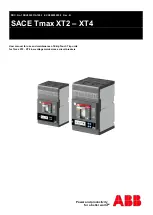
D I S TR I B UTI O N SO LUTI O N S
27
12.1. General information
Maintenance includes the following operations:
• Routine inspection:
checks are performed to
assess the effective conditions of the apparatus
and whether dedicated maintenance work is
required
• Preventive routine maintenance:
Tasks performed
to preserve the required conditions.
• Corrective maintenance:
Tasks performed to
restore correct operation after faults.
All maintenance work must be performed in
accordance with the regulations in force in
the country where the apparatus is
installed.
The maintenance operations must be performed by
specialized personnel, who have been duly trained
and informed about the characteristics of the
apparatus in question.
Inspection and maintenance frequency for
components subject to wear are established on the
basis of the effective conditions in which the
apparatus is used, i.e. operation frequency, length
of time in service and number of short-circuit
interruptions, environmental pollution conditions
and presence of semi-conductive dust.
Since the real conditions of use vary to a great
extent between one installation and the other, they
cannot be known to ABB. The frequencies given are
purely indicative since they are based on an average
degree of use in subway and tramline installations.
Users should acquire familiarity with the typical
conditions of use in their installations and keep
track of the observations reported in successive
inspections so as to establish the best frequency
with which inspections and preventive maintenance
should be performed.
Instructions for replacing spare parts are supplied
with the relative kits.
Frequency in normal conditions
Operation
The event that occurs first among
those listed below:
Every 18 months
- 25000 operations without load
- 400 operations up to rated
load
- 6 current interruptions due to
overload
Visual inspection
Check safety rings.
Tighten screws.
Clean insulating parts
Inspect kinematic chain.
Check main contacts and
arc chute for wear.
Frequency in normal conditions
Operation
The event that occurs first among
those listed below:
Every 18 months
- 50000 operations without load
- 800 operations up to rated
load
- 12 current interruptions due to
overload
Basic inspection
Check pressure of
contacts.
Carefully inspect the arc-
quenching chute.
Check electric contact
between circuit breaker
and arc-quenching chute.
Frequency in normal conditions
Operation
The event occurs in random way
Revamp the surface of
fixed and mobile contacts
with 150-grit emery cloth
Check the pressure of
contacts measuring the
resistance of main circuit
that must not exceed 70
µOhm
Inspect accurately the
arc-quenching chute
Verify the electrical
contact between the
circuit breaker the arc-
quenching chute
12.2.2. Main inspection
12.2.3. Inspections of contacts after short-circuit
interruption
12.3. When parts need to be
replaced
Kits
When parts need to be replaced
Main
contacts kit
When wear on the contacts reaches 2 mm
When contact resistance exceeds 70 µOhm
after trimming and cleaning
If guides have been perforated
If arc quenching path has been perforated
Arc chute kit
Every 800 operations under rated load
Every 12 current interruptions due to overload
If more than 6 plates touch each other
Presence of evident melting between plates
Ceramic
guides kit
Every 800 operations under rated load
Every 12 current interruptions due to overload
Auxiliary
contacts kit
If a fault occurs
Flexible
connection
kit
After 100000 mechanical operations
—
12. Maintenance
12.2. Routine inspections
12.2.1. Basic inspection


































